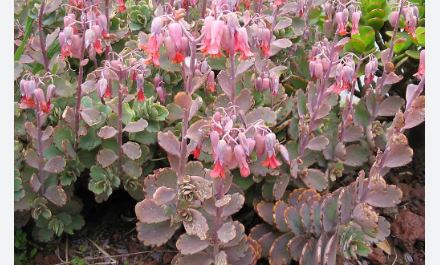
Kalanchoe fedtschenkoi, formerly known as Bryophyllum fedtschenkoi, native to Madagascar, is widely sold as a house or garden plant that has established itself in the wild in some southern parts of the United States of America. Its specific epithet fedtschenkoi honors botanist Boris Fedtschenko (1873-1947).
Kalanchoe fedtschenkoi is a low-growing, frost-tender perennial succulent which prefers dry, open ground. It grows to 10–12 inches (25–30 cm) tall as an untidy, low, rounded herb. The stems are round, smooth and lax with visible leaf scars, often bending and touching the ground where they produce roots and new plants.
Leaves are fleshy, alternate, blue-green and oval or obovate with fine scalloped edges, the edges may turn pink or red under strong sunlight or drought conditions. Commonly called ‘Lavender Scallops’ from the shape and color of its leaves. It has few pests but may harbor mealy bugs or occasionally scale insects.
Characteristics of Kalanchoe fedtschenkoi (Lavender Scallops)
- Appearance: Kalanchoe fedtschenkoi is known for its attractive, scalloped leaves which are initially green but develop a lavender tint when exposed to bright light, hence the common name “Lavender Scallops.”
- Leaves: The leaves are fleshy, spoon-shaped, and have a blue-green base color with a pink or purple edge, especially when grown in full sun. They can also produce tiny plantlets along the edges, similar to other Kalanchoe species.
- Growth Habit: This plant has a spreading, slightly sprawling habit, with stems that can grow up to 1 to 2 feet long, forming a low-growing mat. It can also develop a compact, bushy form if kept trimmed.
- Flowers: Produces clusters of small, bell-shaped flowers that are typically pink, yellow, or orange, appearing on tall stems above the foliage. Flowering is more common in its native environment but can be encouraged with proper care in cultivation.
Cultivation of Kalanchoe fedtschenkoi
- Light: Prefers full sun to partial shade. The plant will develop its best coloration in bright light, but it can handle some shade, especially in hotter climates where too much direct sun might scorch the leaves.
- Water: Water moderately during the growing season, allowing the soil to dry out between waterings. It’s drought-tolerant once established, so it’s better to underwater than overwater. Reduce watering in winter when the plant is dormant.
- Soil: Needs well-draining soil. A typical succulent or cactus mix with added perlite or sand for extra drainage is ideal.
- Temperature: Does best in temperatures between 65-80°F (18-27°C). It can tolerate cooler temperatures briefly but protect from frost as it’s not frost hardy.
- Humidity: Adaptable to typical indoor humidity levels. Its succulent nature makes it quite forgiving of dry air.
- Fertilizer: Use a balanced, low-nitrogen fertilizer formulated for succulents during the growing season. Fertilize sparingly, perhaps once a month, diluted to half strength.
- Propagation:
- Leaf Cuttings: Lay leaves on top of the soil, and they will produce new plants from the leaf edges.
- Stem Cuttings: Cuttings can be taken from the stem, left to callus for a few days, then planted in soil.
- Pruning: Prune back to keep the plant bushy or to remove leggy growth. It can also encourage more branching and a fuller appearance.
- Pests: Generally resistant, but can occasionally get mealybugs, scale, or aphids. Use insecticidal soap or neem oil if pests are present.
- Repotting: Repot every couple of years or when it outgrows its pot. Choose a pot with good drainage and go up only one size.
Additional Tips
- Safety: Contains bufadienolides, which can be toxic if ingested, so care should be taken with pets and small children.
- Variety: There are variegated forms of Kalanchoe fedtschenkoi with cream or yellow margins on the leaves, which are particularly attractive.
- Outdoor Growing: If grown outdoors, ensure it’s in a well-draining area. It can be used as ground cover or in rock gardens where its spreading nature can be appreciated.
- Indoor Growing: Suitable for hanging baskets or as part of a succulent arrangement where its trailing habit can cascade down.